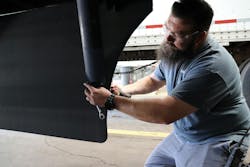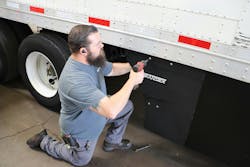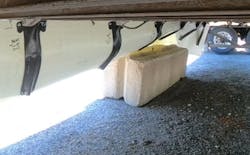Skirting the issue: Trailer side skirt maintenance 101
Key Highlights
- Trailer side skirts one of several devices that can increase a trailer's aerodynamics, and thus its fuel efficiency
- Trailer fairings don't often have many maintenance needs, but it's still important to inspect them frequently for holes, scratches, and bends. Also, be sure to check your trailer skirt's mounting systems for breaks or looseness
- If a side skirt does get damaged, sometimes you can replace the singular panel that's damaged, or replace the entire skirt. If you do, just make sure it's installed correctly by checking the mounting posts and brackets, as well as the torque on mounting posts and nuts, and the safety tethers are installed
Trailer side skirts are a relatively simple and cost-effective add-on that can do a world of good when it comes to aerodynamics and fuel economy. They are often overlooked and underappreciated, so it’s time to shine a spotlight on them.
Made of lightweight materials such as fiberglass or thermoplastic composites, these long, thin panels hang from the trailer’s flanks to close the gap to the road, blocking wind from making its way toward the trailer’s bogie. They are most effective when they extend from the landing gear to the front trailer axle and are as low to the ground as possible.
And while there’s not a whole lot to these aero devices, they provide several benefits.
Skirt makers say a tractor-trailer can save roughly 4 to 7% in fuel. North American Council for Freight Efficiency, meanwhile, found 2-3% fuel economy improvement is a solid baseline expectation.
“By streamlining airflow to reduce drag, side skirts help fleets reduce diesel fuel consumption and CO2 emissions, meet regulatory requirements, improve electric range, and boost the bottom line,” said Paul Provencher, program manager for aerodynamic devices at Transtex, a manufacturer of trailer aerodynamic solutions.
Aside from the fuel savings, they also offer a safety advantage.
“When you reduce air turbulence around the trailer, you get better stability at higher speeds, which is really important for long-haul trucks,” said Jason Paauwe, head of trailer sales for North America at ZF, whose broad truck and trailer product portfolio includes trailer braking systems, telematics, and aerodynamic devices.
Fleets, including their maintenance teams, also benefit from the fact that many of today’s side skirt options are engineered far better than in years past.
“Early on, maybe 15 years ago, a lot of side skirts didn’t last very long,” NACFE Executive Director Mike Roeth said. “They were either really rigid or too flimsy. It wasn’t uncommon to hear about them cracking or falling off. The big challenge was when going over a curb or railroad crossing, or traveling across a yard and banging into a pallet or other obstacle. But a lot of those issues have been fixed through improved product designs over the past five to seven years.”
Side skirts are often made of composite materials nowadays, and are engineered to flex and absorb some degree of impact. Under the right circumstances, they’ve been known to last the life of a trailer with little to no maintenance issues. But as resilient as these things are, that doesn’t mean fleets can completely ignore them.
“Side skirts can take a beating in certain situations,” said Justin Morgan, director of engineering at Energy Guard, a provider of aerodynamic solutions for the trucking industry. “Steep dock approaches, railroad crossings, or anywhere the trailer needs extra clearance can put them in harm’s way. They can also get dinged by snowbanks, fire hydrants, or other fixed obstacles when making tight turns. Road debris—especially from blown tires—can do a number on them, too.”
What to keep an eye on
That damage can impact the aero benefits of side skirts, much like a paper airplane loses its zip the more times you crash it. So it is important to regularly inspect your fairings.
Paauwe pointed out damaged, bent skirts can actually drag down fuel economy more than if a side skirt wasn’t even installed.
“Even a small tear or dent could disrupt airflow, which impacts the skirt’s ability to minimize air resistance,” Paauwe explained. “The same can be said of a skirt that has become partially detached or is improperly aligned. The nice thing is that these things are relatively easy to see.”
Morgan suggested that fleets do “quick and frequent” side skirt checks, preferably after each trip.
A thorough visual inspection should take around 10 minutes, according to Connor Smith, quality control manager at Transtex. He said the following should be inspected:
Outside the panels – Look for holes, deep scratches, delamination at edges, and major changes in the shape of the panel.
Inside the panels – Check tightness of the flange bolts clamping the brackets to the trailer’s crossmembers, and tighten loose bolts and flange nuts as required. Also, look for signs of broken brackets.
At Transport Service, a Translead dealer and repair shop in North Royalton, Ohio, mounting issues due to broken brackets are the most common problem for side skirts, said the shop’s lead trainer, Mike Conley.
“The things I look for the most is just to make sure that the skirt’s attached to the crossmember, and that all the bolts are present,” he said. “When one of those bolts comes out, you’ve got to think about the vibration from the wind. If it starts getting loose and starts to vibrate, everything else is going to vibrate.”
The tech also needs to have the right tools.
“When inspecting a side skirt, the technician should have a ratchet with a torque meter handy to make sure all connections remain properly torqued,” Paauwe added. “While under there, a technician could also look for scuffing on the I-beams, which could indicate that the side skirt’s brackets have been moving and are either damaged or simply in need of tightening.”
Morgan said it’s wise to not only look, but touch.
“A good hands-on step is to give the skirt a push and pull near each bracket,” Morgan said. “If it feels loose, the bracket may be damaged or coming apart.”
Drivers’ role
Drivers can also help keep an eye on side skirts, if you can get them to care. When it comes to trailers in general, this is not all that common.
“One of a fleet’s biggest complaints is that drivers often fail to report things, especially with trailers,” said Jose Caraballo, a senior technician at Transport Services. “With tractors, the driver feels like it’s theirs, so they feel more of a sense of ownership and give it the proper attention. With trailers, they just pick it up and drop it off, and don’t seem to care as much about what happens to it. Small problems can grow into big ones.”
Electronic DVIRs (eDVIRs) help ensure that trailer issues get reported by making communication more convenient than cumbersome paper inspections. But according to Carl Cutler, principal product manager at Zonar, even eDVIRs have their limitations. He asserted Zonar’s EVIR, on the other hand, provides an element of verification that encourages drivers to actually inspect what they’re supposed to be inspecting—including side skirts, if a fleet so chooses.
“Zonar’s EVIR system uses NFC (near field communication) tags at strategic locations around a trailer,” Cutler explained. An NFC tag is a plastic tag that sticks to the trailer and contains a chip. While companies have used RFID tags in the past, NFC tags use technology akin to Apple Pay on an iPhone, Cutler noted, and provide timestamps throughout a driver’s inspection.
“Those timestamps help show if the driver just did a quick lap around the trailer, or if they spent some time at each zone and actually did a 10-minute overall inspection,” he said.
Cutler said most fleets focus on inspection points that simply help them maintain DOT compliance. However, more fleets are wanting to customize their inspections by adding optional items, including side skirts. They can do this by adding inspection items to one of the three NFC tags at different zones around the trailer in Zonar’s inspection builder tool.
The NFC tags above the rear wheels are a good place to add side skirt inspections, Cutler said.
“Our inspection builder tool shows pictures of different trailer systems and accessories you can add, such as side skirts. You just click on the picture to add it. Once saved, that updates the configuration and also syncs to all the mobile apps being used in the field by drivers, technicians, or whomever.”
Now, when a driver scans an NFC tag above the rear wheels, side skirts are on the list of items that must be inspected.
“What’s nice is that the driver can note any abnormal conditions they see right in the app,” Cutler said.
The different conditions are listed in a drop-down menu that is also customizable. So, with side skirts, a fleet could add conditions like minor crack, loose hardware, rust visible, etc. The driver could also take a photo and attach it to the inspection report so a technician can see what’s going on. Zonar EVIRs can also tie into shop maintenance software through an API, making it seamless to get reported defects into the shop maintenance queue.
Repair or just replace?
Whenever a side skirt is damaged, a technician must determine if it’s repairable or if it makes more sense to simply replace the skirt.
“If there’s a crack, keep an eye on it,” Energy Guard’s Morgan said. “Small cracks can be stable. But once a crack grows large, it’s usually replacement time because it’s hard to repair without losing strength or performance. Additionally, larger cracks are more likely to spread and compromise safety.”
Minor cracks and holes can often be patched up with body fillers or self-adhesive patches. If there is significant delamination at the point of damage, however, it may be necessary to cut out the affected portion and replace it with self-adhesive patches. Whatever you do, follow the manufacturer’s instructions and do it right.
“Fleets can get creative out in the field,” Morgan said. “We’ve seen everything from duct tape patches to zip-tied stitching. The best route is to develop a system that’s simple and low-cost to install and replace when needed, like many modern skirt systems offer today.”
According to ZF’s Paauwe, side skirts are a relatively inexpensive item considering the ROI in fuel savings. He said it’s a good investment to keep a few spare panels in inventory for quick replacements with minimal downtime. Some side skirt manufacturers, including ZF, provide three-panel skirts, so a technician can just replace the panel containing damage, reducing cost and servicing time.
Wabash also offers a modular panel design that allows for single-panel replacement. But installing an entire Wabash DuraPlate AeroSkirt can be done in less than two labor hours, according to the company.
“I’ve had a lot of experience with side skirts over the years,” said Paul Pettit, vice president of maintenance at Ascend Transportation, a dry van, full-truckload carrier based in Jackson, Tennessee. He first began handling side skirts in 2012 and has seen significant changes in brackets and skirt material.
“Our drivers have had some serious accidents, and the skirts we use are virtually indestructible,” he said. “If a panel ever does happen to get damaged, we typically remove and replace that side only. The cost for the skirt and labor to rehang it would be very comparable to having someone repair the skirt.”
Whether installing a single panel or an entirely new side skirt, executing a flawless installation is key. Paauwe said many side skirt issues a fleet might run into can tie back to a poor installation.
“They aren’t difficult to install, unless the technician isn’t paying close attention to what they’re doing,” Paauwe said. “The good thing is, it’s fairly easy to see if one side of the skirt is more angled than the other. So, it’s a good idea to double-check that type of thing after a month or so in service.”
One leading manufacturer of trailers and trailer aerodynamic solutions offers the following advice on what technicians should check after installing a side skirt to ensure safety and proper performance:
- Check the location of each mounting bracket to ensure that all panels and components aren’t sticking out past the edge of the base rail.
- Ensure that each mounting post has the correct number of bolts and nuts, and that they are installed flush to the panel and free of burrs.
- Ensure proper torque on all mounting posts and nuts.
- Ensure that the safety tethers have been installed, one per panel section, at roughly the midpoint between each post. Confirm they are flush to the panel with no burrs under the tether. Confirm proper torque on all nuts and bolts.
- Push and pull on the skirt at the posts to ensure that the mounting posts flex as intended and return to their original vertical position.
Trailer skirts now comprise materials and design features that can take a pretty good beating in the field. But that doesn’t mean they’re bulletproof. Technicians need to remain vigilant and not take for granted how sturdy these skirts are most of the time.
And drivers should be reminded that harsh turning and excessive speeds on bumpy roads can lead to damage that puts a skirt out of commission.
“Drivers must also understand the reduced ground clearance of their skirt-equipped trailers, and how that impacts their ability to properly navigate angled docks, curbs, and other vehicles,” Transtex’s Provencher added.
Fleet managers should also make sure drivers are aware of the skirt-to-ground distance.
By ensuring proper installation, careful operation, and rigorous inspection, a trailer skirt can be a relatively trouble-free, cost-effective accessory for many years.
About the Author

Gregg Wartgow
Gregg Wartgow is a freelancer who Fleet Maintenance has relied upon for many years, writing about virtually any trucking topic. He lives in Brodhead, Wisconsin.



